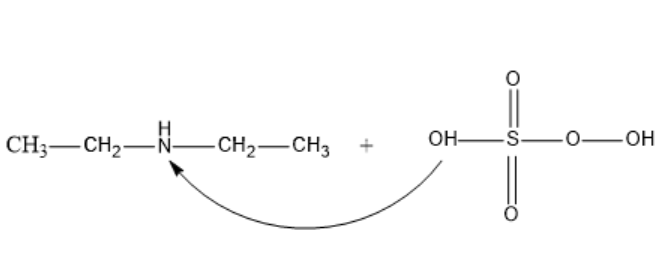
Diethyl amine is treated with ${{H}_{2}}S{{O}_{5}}$(Caro’s acid) to give,
1. Tetraethyl hydrazine
2. Diethyl ether
3. Diethyl hydroxyl amine
4. Ethyl alcohol and ethyl amine
Answer
395.7k+ views
Hint: To answer this question, we need to recall that the reaction between secondary amines and Caro’s acid (peroxy mono sulphuric acid). Diethyl amine is a secondary amine as the amine group ($N{{H}_{2}}$) is linked to a secondary carbon atom.
Complete answer:
In the general reaction of amines, we saw that the reaction between secondary amines and Caro’s acid (peroxy mono sulphuric acid) leads to the formation of Dialkyl hydroxylamine as the final product. Caro’s acid is one of the strongest oxidising agents. It oxides the Dialkyl amine and itself reduces to sulphuric acid. It works as an –OH donor.
General reaction of Amine with Caro’s acid- (R is the alkyl group)
$R-NH-R\text{+ }{{\text{H}}_{2}}S{{O}_{5}}\text{ }\to \text{ R}-N(OH)-R+\text{ }{{\text{H}}_{2}}S{{O}_{4}}$
Let us first see the structure of diethylamine:

Structure of Caro’s acid (peroxy mono sulphuric acid):

In Caro’s acid we can see that there are two free hydroxyl groups one attached to Sulphur and the other attached to oxygen.
Now, the chemical reaction between Diethylamine and Caro’s acid (peroxy mono sulphuric acid) at 373K results in the formation of Diethyl hydroxyl amine and Sulphuric acid.
${{C}_{2}}{{H}_{5}}-NH-{{C}_{2}}{{H}_{5}}\text{ + }{{\text{H}}_{2}}S{{O}_{5}}\text{ }\xrightarrow{373K}\text{ }{{C}_{2}}{{H}_{5}}-N(OH)-{{C}_{2}}{{H}_{5}}+\text{ }{{\text{H}}_{2}}S{{O}_{4}}$
We can observe that the –H attached to nitrogen in diethyl amine is substituted by –OH in the product to form Diethyl hydroxyl amine.
In the structural formula, let’s understand that the – OH group attacks the Diethylamine on the Nitrogen atom and displaces the –H.

The resultant structure formed of Diethyl hydroxyl amine will be:

The structural chemical reaction is-


So, the correct answer is “Option 3”.
Note:
Caro’s acid is formed by the reaction between Hydrogen peroxide (${{H}_{2}}{{O}_{2}}$) and sulphuric acid (${{H}_{2}}S{{O}_{4}}$). So, it has peroxy in its IUPAC name. Caro’s acid is a clear, colourless solution and has an oily uniformity. It also has the ability to destroy alcohols, phenols, aldehydes and ketones.
Complete answer:
In the general reaction of amines, we saw that the reaction between secondary amines and Caro’s acid (peroxy mono sulphuric acid) leads to the formation of Dialkyl hydroxylamine as the final product. Caro’s acid is one of the strongest oxidising agents. It oxides the Dialkyl amine and itself reduces to sulphuric acid. It works as an –OH donor.
General reaction of Amine with Caro’s acid- (R is the alkyl group)
$R-NH-R\text{+ }{{\text{H}}_{2}}S{{O}_{5}}\text{ }\to \text{ R}-N(OH)-R+\text{ }{{\text{H}}_{2}}S{{O}_{4}}$
Let us first see the structure of diethylamine:

Structure of Caro’s acid (peroxy mono sulphuric acid):

In Caro’s acid we can see that there are two free hydroxyl groups one attached to Sulphur and the other attached to oxygen.
Now, the chemical reaction between Diethylamine and Caro’s acid (peroxy mono sulphuric acid) at 373K results in the formation of Diethyl hydroxyl amine and Sulphuric acid.
${{C}_{2}}{{H}_{5}}-NH-{{C}_{2}}{{H}_{5}}\text{ + }{{\text{H}}_{2}}S{{O}_{5}}\text{ }\xrightarrow{373K}\text{ }{{C}_{2}}{{H}_{5}}-N(OH)-{{C}_{2}}{{H}_{5}}+\text{ }{{\text{H}}_{2}}S{{O}_{4}}$
We can observe that the –H attached to nitrogen in diethyl amine is substituted by –OH in the product to form Diethyl hydroxyl amine.
In the structural formula, let’s understand that the – OH group attacks the Diethylamine on the Nitrogen atom and displaces the –H.

The resultant structure formed of Diethyl hydroxyl amine will be:

The structural chemical reaction is-


So, the correct answer is “Option 3”.
Note:
Caro’s acid is formed by the reaction between Hydrogen peroxide (${{H}_{2}}{{O}_{2}}$) and sulphuric acid (${{H}_{2}}S{{O}_{4}}$). So, it has peroxy in its IUPAC name. Caro’s acid is a clear, colourless solution and has an oily uniformity. It also has the ability to destroy alcohols, phenols, aldehydes and ketones.
Recently Updated Pages
Questions & Answers - Ask your doubts

Master Class 11 Accountancy: Engaging Questions & Answers for Success

Master Class 11 Science: Engaging Questions & Answers for Success

Full Form of IASDMIPSIFSIRSPOLICE class 7 social science CBSE

In case of conflict between fundamental rights of citizens class 7 social science CBSE

Can anyone list 10 advantages and disadvantages of friction

Trending doubts
10 examples of friction in our daily life

The correct order of melting point of 14th group elements class 11 chemistry CBSE

Difference Between Prokaryotic Cells and Eukaryotic Cells

One Metric ton is equal to kg A 10000 B 1000 C 100 class 11 physics CBSE

What is the specific heat capacity of ice water and class 11 physics CBSE

State and prove Bernoullis theorem class 11 physics CBSE




